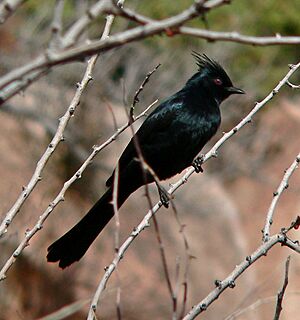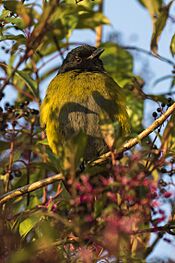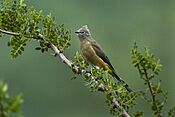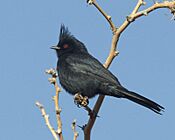Silky-flycatcher facts for kids
Quick facts for kids Silky-flycatchers |
|
|---|---|
 |
|
| Phainopepla (Phainopepla nitens) | |
| Scientific classification |
|
| Kingdom: | Animalia |
| Phylum: | Chordata |
| Class: | Aves |
| Order: | Passeriformes |
| Infraorder: | Passerida |
| Family: | Ptiliogonatidae Baird, 1858 |
| Genera | |
|
|
| Synonyms | |
|
|
Silky-flycatchers are a small family of birds known for their incredibly soft, silky feathers. This group, officially called Ptiliogonatidae, includes only four different types, or species, found in three main groups called genera. They got their name because of their beautiful, smooth feathers and their clever way of catching insects in the air, just like some flycatcher birds do. Even though they are called "flycatchers," they are not closely related to the Old World or tyrant flycatchers.
Contents
Where Silky-Flycatchers Live and Travel
These interesting birds mostly live in Central America, from Panama all the way up to Mexico. One special kind, the phainopepla, even travels further north into the southwestern United States. Most silky-flycatchers don't fly long distances to migrate. Instead, they often wander around their local areas, looking for tasty fruits. However, the phainopepla does migrate, moving between different areas in the northern parts of its home range.
What Silky-Flycatchers Look Like
Silky-flycatchers are related to waxwings, and like them, they have very soft, smooth feathers. Their feathers are usually gray or a pale yellow color. Most silky-flycatchers have a small crest of feathers on their heads, which looks a bit like a tiny crown. The only exception is the black-and-yellow phainoptila, which doesn't have this crest.
These birds are typically slender, meaning they are quite thin, and they measure about 18 to 25 centimeters long. That's roughly the length of a standard ruler! Again, the black-and-yellow phainoptila is a bit different, being a little less slender.
One cool thing about silky-flycatchers is that males and females often look different. This is called sexual dimorphism. Males might have brighter feather colors or longer tails than females. Young birds, called juveniles, usually have colors similar to the adult females.
What Silky-Flycatchers Eat
Silky-flycatchers enjoy eating both fruits and insects. They are quite adaptable in their diet. The phainopepla, in particular, really loves the berries from a plant called desert mistletoe (Phoradendron californicum). This plant is a very important food source for them in their desert homes.
Silky-Flycatcher Homes and Nests
You can find these birds in various types of woodlands. For example, the phainopepla lives in semi-desert areas where there are enough trees. All silky-flycatchers build their nests high up in trees, keeping their young safe.
Meet the Silky-Flycatcher Family!
There are four species of silky-flycatchers, grouped into three different genera:
| Image | Genus | Species |
|---|---|---|
 |
Phainoptila |
|
 |
Ptiliogonys |
|
 |
Phainopepla |
|

